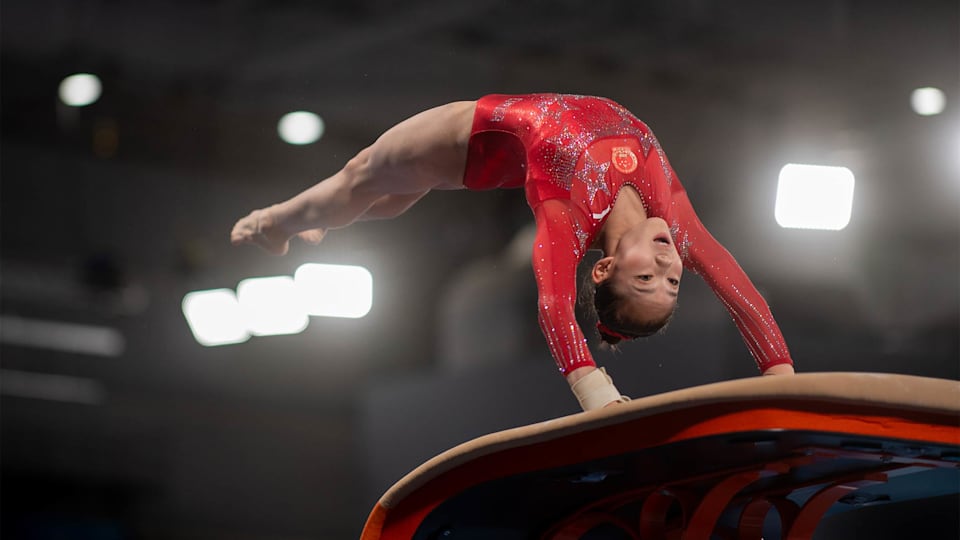Kitazono makes history and gymnastics breaks new ground at Buenos Aires 2018
Japan’s Takeru Kitazono lit up the artistic gymnastics competitions at the Youth Olympic Games Buenos Aires 2018, becoming the first athlete in his sport to win five gold medals at a single YOG and one of the few athletes in Olympic history to achieve such a haul. His sport also opened up new horizons with the successful staging of an innovative and exciting multidiscipline team event.

There was a time when it would have been unthinkable for gymnastics – a sport rooted in tradition and decorum – to stray from Olympic conventions. The organisers of the gymnastics competitions at the Youth Olympic Games Buenos Aires 2018 chose to break with the past, however, coming up with an innovative format that proved a huge success.
That success is partly down to Terhi Toivanen, Sports Event Manager at the International Gymnastics Federation, who, along with her colleagues, dedicated a lot of time to putting the programme together. “We decided not to go with the traditional Olympic concept,” she explained. “We wanted to be different, and you can only do that at the Youth Olympic Games. So we chose to introduce the multidiscipline team event and revamp the competition schedule. I think it was all worthwhile. Obviously it was all a bit nerve-wracking before the start, but things worked out well in the end.”
The all-new multidiscipline event saw artistic, rhythmic and acrobatic gymnasts from different nations form 12 teams, each comprising 13 athletes, both male and female. The teams were named after some of the sport’s legendary figures, among them Nadia Comaneci (ROU), Max Whitlock (GBR) Simone Biles (USA), and Rosie McLennan (CAN).
“The youngsters all seemed to have a great time and they made friends with other gymnasts whom they’d never competed with before,” added Toivanen. “After the competition they were walking around town with their teams’ T-shirts on, which was pretty cool. I think this format is the future of the YOG. Obviously there are some things that need to be improved and maybe the competition schedule, with four days devoted to qualifications, wasn’t the best idea for every discipline.”
While the acrobatic gymnasts completed qualifying in a single day, their artistic counterparts were in action across all four days of the competition. “It was a bit difficult for the gymnasts, but even more so for the people in charge of the apparatus, who had to change the layout a little every day,” said Toivanen.
The event was won by team Simone Biles, consisting of Mariela Kostadinova and Panayot Dimitrov (BUL) in acrobatic gymnastics; Ruan Lange (RSA), Krisztian Balazs (HUN) and Nazar Chepurnyi (UKR) in men’s artistic gymnastics; Tamara Anika Ong (SGP), Nhu Phuong Pham (VIE) and Alba Petisco (ESP) in women’s artistic gymnastics; Talisa Torretti (ITA), Daria Trubnikova (RUS) and Yelyzaveta Luzan (AZE) in rhythmic gymnastics; Liam Christie (AUS) in men’s trampoline and Fan Xinyi (CHN) in women’s trampoline. Team Max Whitlock, featuring the prolific Takeru Kitazono, took the silver.
The exciting multidiscipline event, which featured no national anthems or flags but lots of young talent, also served as a qualifying competition for each of the disciplines, with several of the athletes going on to win yet more medals in their chosen events, with Kitazono taking more than most.
A five-star performance
In winning the all-around, floor, rings, parallel bars and horizontal bar competitions, the 15-year-old star became the first artistic gymnast to win five gold medals at a single Youth Olympic Games, the first Japanese athlete to win five individual golds at any Olympic Games, and the first athlete in his sport to achieve the feat since Vitaly Scherbo won six golds for the Unified Team (the former Soviet Union) at Barcelona 1992.
Dubbed “Kohei Number Two” after his fabled compatriot Kohei Uchimura – a three-time Olympic gold medallist and six-time world all-around champion – Kitazono exceeded expectations at the Parque Polideportivo Roca, showcasing his unique talent again and again and making light of the pressure on his shoulders.
Neither he nor his coach are going to rest on their laurels, however, with attention already turning to the upcoming Olympic Summer Games, to be held in his home country: “I’m looking to go out and perform the same at Tokyo 2020 and I’m going to train even harder to make that happen.”
In the women’s artistic gymnastics competitions, Italy’s Giorgia Villa became the first athlete from her country to win individual all-around gold. Villa also won vault and floor golds and silver in the uneven bars to become the most decorated female gymnast at Buenos Aires 2018.
In the trampoline events, China’s Fu Fantao and Fan Xinyi claimed respective golds in the men’s and women’s competitions. Fan, who also formed part of the gold medal-winning Team Simone Biles in the multidiscipline event, maintained her country’s perfect record in the women’s competition, with Yu Dong having won gold at Singapore 2010 and Zhu Xueying doing likewise at Nanjing 2014.
Acrobatic gymnastics made its YOG debut in Buenos Aires. The competition took the form of a mixed pair event and was won by Bulgaria’s Mariela Kostadinova and Panayot Dimitrov, who were also gold medallists with Team Simone Biles in the multidiscipline event. Israel’s Noa Kazado Yakar and Yonatan Fridman took the silver and Daryna Plokhotniuk and Oleksandr Madei of Ukraine the bronze.
Russia’s Daria Trubnikova, another multidiscipline gold medallist, took the honours in the rhythmic gymnastics individual all-around competition. Following a hesitant start in the hoop, Trubnikova earned the approval of the judges and the admiration of the spectators in the ball, clubs and ribbon to win by fully 4.300 points over Ukraine’s Khrystyna Pohranychna. Italy’s Talisa Torretti, who qualified for the final in second place, completed the podium, winning her country’s first Olympic rhythmic gymnastics medal.
